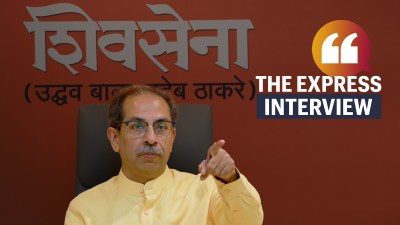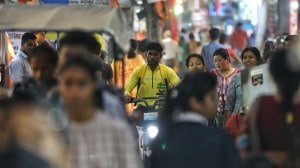- India
- International
Leprosy hasn’t made a comeback in India, new cases due to proactive detection: WHO Goodwill Ambassador
'Early detection and early cure remain a challenge. It is with this that the eradication goal can be achieved,' says Yohei Sasakawa, who is the recipient of Gandhi Peace Prize 2018 for his role in tackling leprosy.
 UN Goodwill Ambassador Yohei Sasakawa met people affected with leprosy in Faizabad, UP in November 2014.
UN Goodwill Ambassador Yohei Sasakawa met people affected with leprosy in Faizabad, UP in November 2014.
Leprosy seems to be back in India if we go by numbers — an estimated 1.27 lakh new cases were detected in the country in 2017. On World Leprosy Day that is being observed in India on January 30, Yohei Sasakawa, the WHO Goodwill Ambassador for leprosy elimination, while on a visit to New Delhi, explains why this is not exactly negative news.
Sasakawa, who is also the chairman of The Nippon Foundation in Japan, is the recipient of Gandhi Peace Prize 2018 for his role in tackling leprosy.
It was in 2005 that India announced to have eliminated leprosy. But there are various reports, including in the media, that the disease has made a comeback in the country in recent years. Is it so?
That is not really the truth. The elimination target set by the World Health Organisation (WHO) was one case per 10,000 people. That target has indeed been achieved in a number of countries. However, it was just a WHO milestone, of elimination, and not eradication.
Prime Minister Narendra Modi has announced to eradicate leprosy from India by the year 2030. In order to achieve that target, there are proactive measures being taken to access all parts of the country for detection of new cases so as to put them under medication for six-10 months and cure them.

The Indian government, even after achieving the WHO milestone, has decided to not stop the anti-leprosy campaign but instead carry out this intensive survey to find new cases. It is not that the disease has made a comeback but it is the approach of trying to eradicate the disease from India that has resulted in the detection of new cases.
I highly value what the Indian government has been doing and would want other countries to follow suit — that is, proactively find new cases. In fact, the rise in the number of new cases is not negative but rather welcoming as it would lead to medication and cure.
 WHO Goodwill Ambassador Yohei Sasakawa who is the recipient of Gandhi Peace Prize 2018.
WHO Goodwill Ambassador Yohei Sasakawa who is the recipient of Gandhi Peace Prize 2018.
Was the 2005 declaration hurried since India had received funding from WHO for leprosy elimination?
At the time when the elimination target was achieved in 2005, many people had thought it to be a miracle. Many believed India cannot achieve it given that it had around 70 per cent cases of the world
However, the WHO elimination target was an evaluation of the entire country. So if you look deeply, say, at Maharashtra or Jharkhand, there were some numbers that were beyond that target.
Setting numerical targets for any disease was in a way the first attempt for any kind of disease for the WHO. However, that target did lead to some misunderstanding and confusion amongst the experts as well. It did not mean eradication.
In 2017, there were 2.1 lakh new leprosy cases registered globally — India accounted for over half of them. Why is that?
There are various diseases that normally come with symptoms like pain, fever, etc. which make people run to hospital for treatment. But in the case of leprosy, especially in its early stage, there are no symptoms except for discoloured body parts sometimes.
ASHA workers, who visit each and every household to try and find new cases, have been able to detect hidden cases. That I would consider is an achievement in the country. This proactive search of hidden cases has contributed to the rising number of leprosy cases.
But it’s just a temporary rise in new cases for either maybe one or two years. In 5-6 years’ time, the numbers will be dramatically lower than what it is now.
Post-2005, did the Indian government become lax in terms of policies and funding, thereby allowing the disease to go undetected or spread again?
It happened with most of the countries. Once they achieved the 2005 target, they became complacent. That is one of the many reasons that in many countries, including India, the number of new cases has risen.
Do you think India can be leprosy-free by 2030 as envisaged by the government?
I do hope this goal is achieved. What is important is having this strong will to achieve. I would like to keep my hope high.
What are the key challenges in tackling leprosy in India?
Early detection and early cure remain a challenge. It is with this that the eradication goal can be achieved.
There is another huge misunderstanding that the disease is highly contagious. There are many older people who were affected by leprosy while young, and developed disability for want of medication. While they have been put on medication and cured of bacteria, the disability remains, leading people to believe that the disease is transmitted easily and is incurable.
The stigma around the disease remains. It is a human rights issue that has to be tackled. Such people need to be employed and given rightful place in society.
We have to make leprosy a part of everyday conversation.
What is the global situation of leprosy?
India, Indonesia, Brazil are among the main countries where leprosy is prevalent. While India has taken strides in tackling the disease, Brazil and Indonesia are lagging behind. We want the Indian actions to be replicated in the two countries. We also want to have a political commitment from countries affected by leprosy.
Apr 20: Latest News
- 01
- 02
- 03
- 04
- 05






































